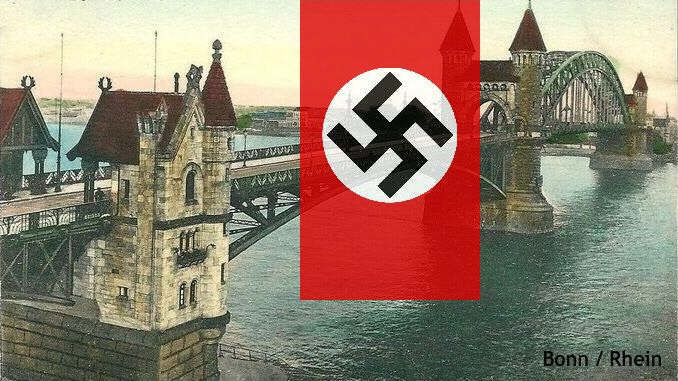
On January 30, 1933, President Hindenburg had finally appointed Hitler Chancellor. Within only a few months, Germany became a totalitarian state, Nazi Germany.
Seizure of power
On the evening of February 27, 1933, a fire broke out in the Reichstag building. Hitler immediately accused the communists, and that very night, he had thousands of communists and other political opponents arrested. Obviously, the Nazis executed prosecution lists drawn up long ago.
The next day, he persuaded Hindenburg to sign an emergency decree that suspended the basic rights of the Weimar Constitution “until further notice”. Now any person or group that was not approved by the government could be imprisoned without any legal remedy. In other words: there was no longer any protection against despotic acts.
Thereafter, the Nazis arrested thousands of communists and socialists and took them to concentration camps. Here, the prisoners were at the mercy of the Gestapo. Hitler set up a People’s Court (Volksgerichtshof) and appointed the judges himself.
Enabling Act
Still Hitler had no majority in the Reichstag, and he was chancellor of a coalition government with the German Nationalists. Therefore, he called for new elections in March 1933. Now the Nazis controlled the radio and terrorized their opponents. But despite all intimidation, the Nazi Party only obtained 44% of the votes, and even with the 8% of the German Nationalists, Hitler had only a narrow majority. Of all the parties in the political center, only the catholic Zentrum had remained with a notable faction.
To exercise power in an outwardly “legal” manner, Hitler demanded a far-reaching Enabling Act. Therefore, on March 21, 1933, he staged a state ceremony for the opening of the new Reichstag at the Garrison Church in Potsdam. This church with the tomb of Frederick the Great stood for the old Kingdom of Prussian and meant a lot to Hindenburg, a Prussian monarchist. The Social Democratic Party and the Communist Party did not attend. Hindenburg appeared in the uniform of an imperial field marshal, Hitler wore black civilian clothes. They had a solemn handshake symbolizing “the marriage of the old grandeur and the new power”.
On 24 March 1933, the Reichstag passed the “Enabling Act”. For the next four years, it transferred the parliament’s legislative power to Hitler’s government. Only the SPD voted against it.
The totalitarian dictatorship
Within a few months Hitler eliminated all organizations that could offer resistance to his dictatorship. He banned the trade unions and all political parties except the Nazi Party NSDAP. Opposition politicians and civil servants were dismissed, among them Konrad Adenauer, Lord Mayor of Cologne. In the summer of 1934, the Nazis did away with the parliaments of the German states, and Hitler proclaimed the Third Reich.
Hitler’s former opponents did not survive his seizure of power for long. He had the former Reich Chancellor von Schleicher murdered, and the SA Chief of Staff Ernst Röhm arrested and liquidated. After the “Night of the Long Knives” in mid-1934, Adenauer, was arrested and spent a short time in prison. During the following two years he changed his place of residence several times, fearing further arrests.
After Hindenburg’s death, Hitler also became Reichspräsident in August 1934. He had Reichswehr and civil servants sworn in personally to him instead of the Weimar Constitution. Now he soon replaced his German Nationalist ministers by loyal Nazis.
Persecution of Jews
The systematic persecution of Jews, ethnic minorities and political opponents began as early as 1933. The Nazi Government decreed a series of laws that restricted the rights of German Jews. In September 1935, the Reichstag passed the so-called Nuremberg “race laws for the protection of German blood and honor”. Jews lost their German citizenship and were forbidden to marry non-Jewish Germans. In the same way, Sinti and Roma (gypsies) and other minorities were discriminated. Also the so-called “Rhineland bastards”, children born to Germans and soldiers from the occupying forces, suffered terribly.
A policy of faits accomplis
Since 1926, Germany was a member of the League of Nations. The Lausanne Conference had cancelled war reparations altogether. In 1932, Hitler called off his negotiators from the Geneva Disarmament Conference and declared Germany’s withdrawal from the League of Nations. Nothing happened.
Hitler succeeded in breaking up the solidarity of the European powers. He pursued a policy of faits accomplis, but the other powers did not intervene. The war in Abyssinia and one year later the Spanish Civil War also divided the great powers. Hitler supported Italy’s ruler Mussolini in Abyssinia and General Franco against the republican government in Spain. Both joined forces with Japan in the Anti-Comintern Pact. Close observers recognized that anti-communism was just a facade because all three countries planned to extend their territories.
Rearmament and invasion of the Rhineland
Hitler pursued a double agenda. He kept asserting his desire for peace, to reassure the foreign powers and give them no reason to take up arms against Germany. But behind this facade, Nazi Germany was already rearming. From 1933 to 1938, Germany spent more on armaments than England, France, and the USA put together.
On March 7, 1936, German troops invaded the Rhineland. Under the Locarno Treaty, Great Britain now had to intervene in France’s favor, but nothing happened, and so this coup further enhanced Hitler’s reputation.
Olympic Games in Berlin
In August 1936, Berlin hosted the Summer Olympics. They should paint a positive picture of Nazi Germany, and so they did. Many foreign visitors to the Games saw a well-organized, hospitable country with peaceful, hard-working people and a head of state who was modest and affable. Of course, he did not shake hands with the outstanding African American athlete Jesse Owens. Hitler had given Germany a place in world politics again, and abroad people began to see his successes. Edward VIII of England, who had abdicated the throne for Wallis Simpson, visited him and admired him openly – which earned him harsh criticism at home.
War Preparations
Already in his book “Mein Kampf”, written in 1924, Hitler had set out his true goals, and he had never given them up. In a secret conference with his supreme commanders on November 5, 1937, he spoke about them openly. He planned for a violent expansion in the East, to obtain “living space” for the 85 million Germans in Europe. The course had long been set for war.
On 12 March 1938 German troops marched into Austria. Two days later, Hitler annexed Austria into Nazi Germany. This gave a boost to the Sudeten Germans who lived in the predominantly German part of Czechoslovakia on the border with the Reich. Hitler instructed them to make ever higher demands on the government in Prague to make an understanding impossible.
The English government under Prime Minister Neville Chamberlain warned Hitler not to use force. However, they would accept a peaceful revision of the border. England’s armament was falling behind, and Chamberlain believed that Hitler could be appeased by meeting justified demands. But Hitler stirred up the crisis, and then the Sudeten Germans revolted. Troops bloodily crushed the uprising, and an understanding had become impossible.
Chamberlain on the Petersberg
Chamberlain twice traveled to Germany to meet Hitler personally and save peace. In September 1938, he came to the Rhine. The Prime Minister and his delegation stayed at the Grand Hotel on Mount Petersberg, with all imaginable comfort. Hitler, on the other hand, resided at Rheinhotel Dreesen in Bad-Godesberg on the other side of the Rhine and had Chamberlain come all the way down there. But the talks failed.
Through Mussolini’s mediation, a conference took place in Munich. In the Munich Agreement of 29 September 1938, Czechoslovakia lost a considerable part of her territory.
The Night of broken Glass
Five years of hateful propaganda, of boycotts and discriminating laws had excluded the German Jews from social and political life. Many of them had left the country.
In the night of 9/10 November 1938, the “Kristallnacht”, almost 100 Jews were murdered and 25,000-30,000 were arrested and taken to concentration camps. All over the country, more than 200 synagogues, thousands of Jewish shops and houses were destroyed.
The road to war
The Munich Agreement did not satisfy Hitler. Breaking the Agreement, German troops marched into Prague on March 15, 1939. The Czechs were forced into a “Protectorate of Bohemia and Moravia”, and Slovakia had to declare herself independent, a German client state, and accept the presence of German troops.
When Poland refused to comply with Nazi Germany’s demands for revision, Hitler reached an agreement with the Soviet Union. Then, on September 1, German troops marched into Warsaw. Now England and France declared war against Nazi Germany.
20th century
The short 20th century | The Great War | German Revolution 1918/19 | Occupation of the Rhineland | Weimar Republic | Nazi Germany | World War II | Federal Republic of Germany

Be the first to comment